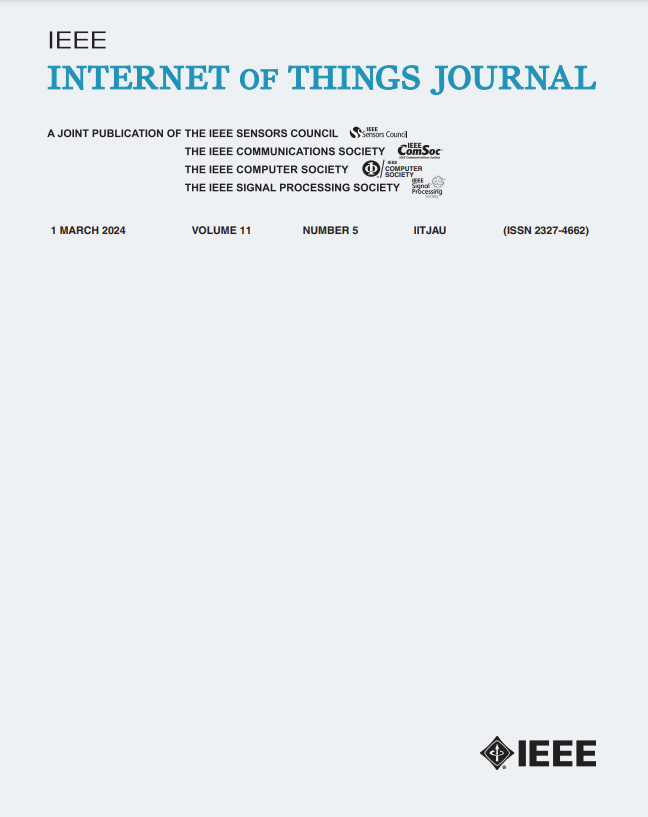Integration of STAR-RIS With Index Modulation: Novel Attraction Solutions for IoT Applications
IF 8.9
1区 计算机科学
Q1 COMPUTER SCIENCE, INFORMATION SYSTEMS
引用次数: 0
Abstract
The integration of the sixth-generation (6G) communication technology with the Internet of Things (IoT) is one of the directions in achieving a digitalized world, aiming to provide ultrahigh-speed communication services that exhibit higher energy-efficiency, lower latency, and heightened reliability and availability. In this article, we investigate the use of the simultaneous transmitting and reflecting reconfigurable intelligent surface (STAR-RIS), one of the candidate technologies for 6G communication, along with the index modulation (IM) in multiantennas ambient backscatter communication system (ABCS) to form the STAR-RIS-assisted ABCS with spatial modulation (STAR-RIS-ABCS-SM). In particular, through the utilization of STAR-RIS and backscatter communication, we meet the demand for low-power wireless communication devices in the green communication, which is also a crucial characteristic of the IoT. Specifically, we introduce STAR-RIS into ABCS, which not only significantly boost the signal strength but also achieve full communication coverage. Meanwhile, we apply the spatial modulation (SM) technology in the multiantennas backscatter tags (BTs), located on both sides of the STAR-RIS, and use joint detection at the reader to enhance the system’s spectral efficiency (SE) as well as its bit error rate (BER) performance. Furthermore, we divide the STAR-RIS into various subsurfaces to form patterns that further enhance SE, which is termed STAR-RIS-assisted ABCS with pattern index and SM (STAR-RIS-ABCS-PISM) scheme. Finally, theoretical BER analytical expressions for both schemes are derived and presented. Simulation and theoretical results demonstrate the enhanced performance of the proposed schemes as well as the validity of the system model.星- ris与指数调制的集成:物联网应用的新吸引力解决方案
第六代(6G)通信技术与物联网(IoT)的集成是实现数字化世界的方向之一,旨在提供具有更高能效、更低延迟、更高可靠性和可用性的超高速通信服务。本文研究了同时发射和反射可重构智能表面(STAR-RIS)作为6G通信的候选技术之一,与多天线环境后向散射通信系统(ABCS)中的索引调制(IM)一起,形成具有空间调制的STAR-RIS辅助ABCS (STAR-RIS-ABCS- sm)。特别是,通过利用STAR-RIS和反向散射通信,我们满足了绿色通信中对低功耗无线通信设备的需求,这也是物联网的一个重要特征。具体来说,我们将STAR-RIS引入ABCS,不仅显著增强了信号强度,而且实现了全通信覆盖。同时,我们将空间调制(SM)技术应用于位于STAR-RIS两侧的多天线反向散射标签(bt)中,并在读取器处使用联合检测来提高系统的频谱效率(SE)和误码率(BER)性能。此外,我们还将STAR-RIS划分为多个子曲面,形成模式,进一步增强SE,称为STAR-RIS辅助ABCS模式索引和SM (STAR-RIS-ABCS- pism)方案。最后,推导并给出了两种方案的理论误码率解析表达式。仿真和理论结果表明,所提方案的性能有所提高,系统模型是有效的。
本文章由计算机程序翻译,如有差异,请以英文原文为准。
求助全文
约1分钟内获得全文
求助全文
来源期刊

IEEE Internet of Things Journal
Computer Science-Information Systems
CiteScore
17.60
自引率
13.20%
发文量
1982
期刊介绍:
The EEE Internet of Things (IoT) Journal publishes articles and review articles covering various aspects of IoT, including IoT system architecture, IoT enabling technologies, IoT communication and networking protocols such as network coding, and IoT services and applications. Topics encompass IoT's impacts on sensor technologies, big data management, and future internet design for applications like smart cities and smart homes. Fields of interest include IoT architecture such as things-centric, data-centric, service-oriented IoT architecture; IoT enabling technologies and systematic integration such as sensor technologies, big sensor data management, and future Internet design for IoT; IoT services, applications, and test-beds such as IoT service middleware, IoT application programming interface (API), IoT application design, and IoT trials/experiments; IoT standardization activities and technology development in different standard development organizations (SDO) such as IEEE, IETF, ITU, 3GPP, ETSI, etc.
 求助内容:
求助内容: 应助结果提醒方式:
应助结果提醒方式:


